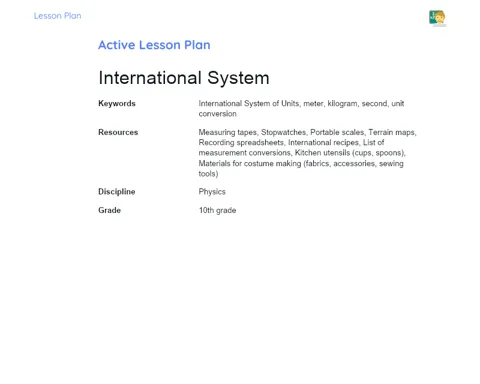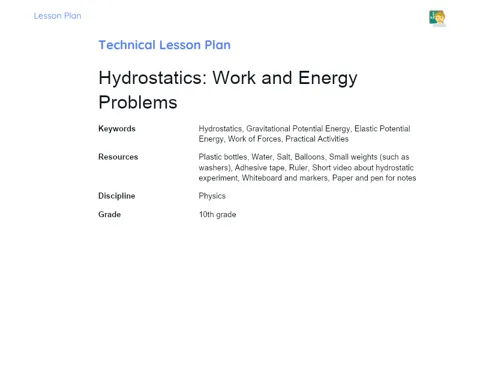Objectives (5 - 7 minutes)
- Understand the concept of impulse and its relationship with momentum.
- Apply the Impulse Theorem in practical situations, using the concepts of mass, initial and final velocity.
- Develop skills to solve problems involving the Impulse Theorem, using mathematics as a tool.
Secondary Objectives:
- Apply the concepts of impulse and momentum in everyday situations, relating theory to practice.
- Develop critical thinking and problem-solving skills through the application of learned concepts.
- Encourage teamwork and active participation of students during the class, through discussions and group problem-solving.
Introduction (10 - 12 minutes)
-
Review of Previous Concepts:
- The teacher will start the class by reviewing the concepts of force, mass, and acceleration, which were previously studied. These concepts are fundamental for understanding the Impulse Theorem. (3 - 4 minutes)
-
Problem Situations:
- The teacher proposes two problem situations to the students:
- A soccer ball is kicked towards a goal. How can we calculate the force of the kick, considering the mass of the ball and the speed at which it was kicked?
- A car is stopped and suddenly accelerates until it reaches a speed of 100 km/h. How can we calculate the force that the car's engine exerted to accelerate it, considering the mass of the car and the time it took for the acceleration? (3 - 4 minutes)
- The teacher proposes two problem situations to the students:
-
Contextualization:
- The teacher contextualizes the importance of the Impulse Theorem, explaining that it is essential to understand how force acts on a moving object, and how we can calculate this force. In addition, the teacher may mention some practical applications of this theorem, such as in the design of spacecraft, in bridge and building engineering, and even in sports like soccer and Formula 1. (2 - 3 minutes)
-
Attention Gain:
- The teacher presents two curiosities or interesting applications about the Impulse Theorem:
- The first is the 'Impulse Paradox', which shows that although the total impulse is the same before and after an event, the change in impulse can be significant. For example, when a skater jumps in the air, he experiences a significant decrease in speed, although the total impulse remains the same.
- The second curiosity is the 'Law of Impulse and Momentum', which states that if no external force acts on a system, the total momentum of the system will remain constant. This is known as the principle of conservation of momentum. (2 - 3 minutes)
- The teacher presents two curiosities or interesting applications about the Impulse Theorem:
Development (20 - 25 minutes)
-
Impulse Theory (8 - 10 minutes)
- The teacher introduces the concept of impulse, explaining that it is the physical quantity that measures the change in momentum of an object over the time a force is applied.
- Next, the teacher presents the impulse formula: Impulse = Force x Time, emphasizing that force and time must be measured in the same direction and sense.
- The teacher explains that impulse is a vector quantity, meaning it has magnitude, direction, and sense. And that, in practice, impulse is the integral of force with respect to time.
-
Impulse Theorem (5 - 7 minutes)
- The teacher introduces the Impulse Theorem, which states that the change in momentum of a body is equal to the impulse of the force acting on it.
- The teacher presents the formula of the Impulse Theorem: Change in Momentum = Mass x (Final Velocity - Initial Velocity), and explains that when the mass of the body is constant, the Impulse Theorem can be written as: Force x Time = Mass x (Final Velocity - Initial Velocity).
- The teacher emphasizes that to apply the Impulse Theorem, it is necessary for the mass of the body to be constant and for the force and velocity to be measured in the same direction and sense.
-
Example Resolution (7 - 8 minutes)
- The teacher proposes the resolution of the two problems presented in the Introduction, using the Impulse Theorem.
- For each problem, the teacher guides the students to identify the provided data, the quantity to be calculated, and the formula of the Impulse Theorem that will be used.
- The teacher assists the students in substituting the values in the formula and solving the equations, step by step, showing how to arrive at the final result.
- During the resolution of the problems, the teacher encourages students to ask questions, express their doubts, and discuss the solutions in groups.
-
Practical Activity (3 - 5 minutes)
- The teacher proposes a practical activity to reinforce learning. Students are divided into groups and each group receives a problem situation to solve, using the Impulse Theorem.
- The problem situations may include, for example, calculating the force of a punch, considering the mass of the fist and the time the force is applied; or calculating the braking force of a car, considering the mass of the car and the time the braking force is applied.
- Students should discuss the problem situation in groups, identify the provided data, the quantity to be calculated, and the formula of the Impulse Theorem to be used, and solve the problem. The teacher circulates around the room, assisting the groups and answering questions.
- At the end of the activity, each group presents its solution and the teacher provides comments, reinforcing the concepts learned.
Return (8 - 10 minutes)
-
Group Discussion (3 - 4 minutes)
- The teacher gathers all students and promotes a group discussion about the solutions found by each group.
- The teacher can start the discussion by asking each group how they approached the problem situation, what difficulties they encountered, and how they overcame them.
- The teacher should encourage the participation of everyone, praising contributions and clarifying any doubts that may arise.
-
Connection with Theory (2 - 3 minutes)
- After the discussion, the teacher makes the connection between the solutions found and the theory presented, highlighting how the Impulse Theorem was applied to solve the problem situations.
- The teacher reinforces that the Impulse Theorem is a powerful tool to understand and predict the movement of bodies, and that practicing problem-solving helps consolidate the understanding of the theory.
-
Final Reflection (3 - 4 minutes)
- The teacher suggests that students reflect for a minute on the following questions:
- What was the most important concept learned today?
- What questions have not been answered yet?
- After a minute of reflection, the teacher invites some students to share their answers.
- The teacher should listen attentively to the students' responses, value contributions, and clarify any remaining doubts.
- The teacher can end the class by summarizing the main points covered and the Objectives achieved.
- The teacher suggests that students reflect for a minute on the following questions:
-
Feedback and Evaluation (1 - 2 minutes)
- The teacher requests feedback from students about the class, asking what they found most interesting and what they would like to learn more about.
- The teacher can also make a quick evaluation of the students' performance, observing the level of participation, engagement in activities, and understanding of concepts.
- The feedback from students and the teacher's evaluation can serve as a basis for planning future classes and adjusting the teaching approach, if necessary.
This Return moment is essential to consolidate learning, clarify doubts, stimulate reflection, and evaluate performance. In addition, it promotes interaction between students and the teacher, strengthening the relationship of trust and respect, which are essential for an effective learning environment.
Conclusion (5 - 7 minutes)
-
Summary of Contents (2 - 3 minutes):
- The teacher summarizes the main points covered in the class, reinforcing the definition of impulse, the Impulse Theorem, and how to apply it in practical problems.
- He recaps the formulas used and the necessary steps to solve the problems, emphasizing the importance of measuring force and time in the same direction and sense.
- The teacher also recalls the problem situations discussed and how the Impulse Theorem was applied to solve them.
-
Connection between Theory and Practice (1 - 2 minutes):
- The teacher emphasizes how the class connected the theory of impulse and the Impulse Theorem with practice, through the resolution of real problems.
- He reinforces that theoretical knowledge is fundamental, but the ability to apply this knowledge to solve practical problems is equally important.
-
Additional Materials (1 - 2 minutes):
- The teacher suggests some complementary study materials for students who wish to deepen their knowledge on the subject. These materials may include physics textbooks, educational videos online, physics simulators, among others.
- He can also indicate extra exercises for students to practice at home, in order to consolidate what was learned.
-
Importance of the Subject (1 minute):
- To conclude, the teacher highlights the importance of impulse and the Impulse Theorem in our daily lives and in various areas of knowledge.
- He can mention examples of practical applications, such as in the design of spacecraft, in bridge and building engineering, and even in sports like soccer and Formula 1.
- The teacher concludes the class by reinforcing that impulse and the Impulse Theorem are not just theoretical concepts, but powerful tools that help us understand and predict the movement of bodies, and that mastering these concepts is essential for good performance in physics.



